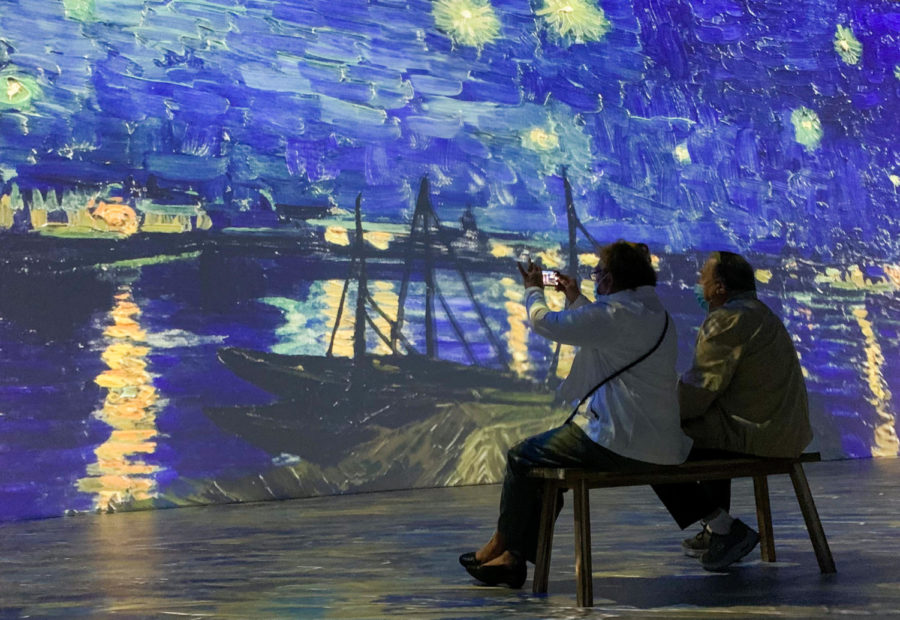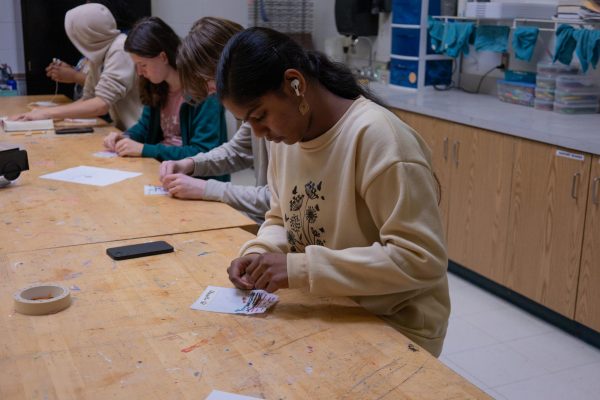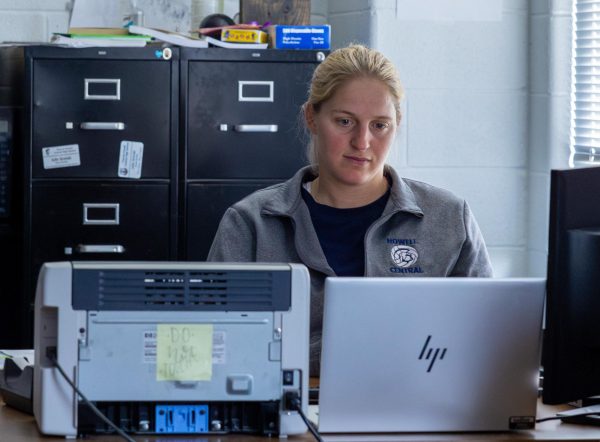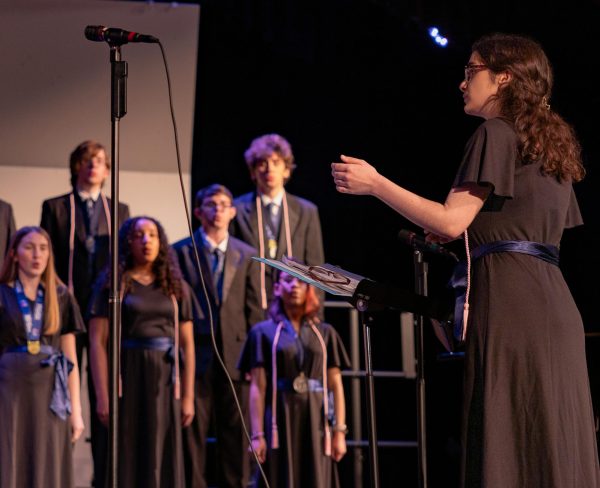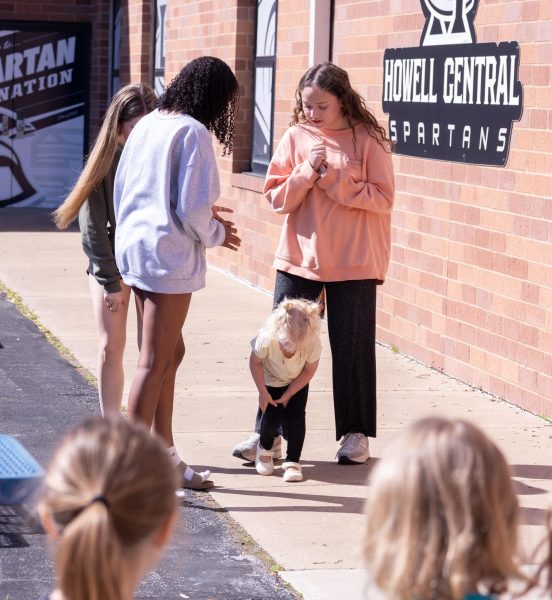Gogh-ing Above and Beyond
The Beyond Van Gogh exhibit immerses patrons in art
A couple trying to capture a moment in the Beyond Van Gogh exhibit. Phones without flash were encouraged in the event so people could share and support the exhibit.
For many, art in its natural habitat, a museum exhibit, may seem boring, motionless, lifeless. The Beyond Van Gogh exhibit currently being displayed near the Galleria Mall does just the opposite of what typical museums do. Instead of showing you a piece of work illuminated by a spotlight with a small label that contains a brief history of the artist, they take projections and a white room and put you in the artwork itself. According to the manager of the Beyond Van Gogh Exhibit Sue Silverstein, this immersive experience took a lot of work from the get-go.
“We actually had to start from scratch, we had to put new asphalt on the ground to level everything out,” Silverstein said.
Although starting from scratch seems like a lot of time, the team was still able to get the tent and projections up and running in a short amount of time.
“It’s a shorter process than you would think,” Silverstein said. “From start to opening it was about two weeks and that allowed us to do the concrete, the building of the tent, and get everything up and running.”
However, despite the timely setup like most exhibitions, this exhibit still requires constant maintenance to make sure the projections are working optimally.
“We have projectionists that are in every day running the show and when it ends they come into the room, put up a big grid to see where the lines are out of alignment, and then they have to go in and realign the entire show,” Silverstein said.
Due to the setup being in a tent, constant maintenance is crucial since weather can affect the quality of the experience.
“One of the cons about being in a tent is it picks up wind gusts and bumps our projectors out of line.” Silverstein said, “So sometimes it’s a simple fix in the computers and other times they have to go up and do it.”
Recently senior AJ Vargas visited the exhibit and shared that his favorite part was not the projections, but learning about Van Gogh from a new perspective in “Information Hall.”
“This is probably an unpopular opinion, but reading about Van Gogh’s life and his relationships with his brother and friends was definitely my favorite part,” Vargas said, “Artists lives are so deeply interesting to me because they are practically inseparable from the art they create, so by learning more about the artist’s life you can gain a deeper insight into their works.”
For Vargas, seeing their portrayal of Van Gogh as “human” was almost relieving due to common misconceptions about the artist.
“I was really nervous beforehand about the possibility that the exhibit would focus too much on his bad mental health and his infamous act of cutting off his ear too much because mainstream media really likes to romanticize mental illness in the art world to push the ‘tortured artist’ narrative which is toxic,” Vargas said, “I would like to think that Van Gogh would still have been able to make beautiful art without needing to be severely mentally unstable.”
According to Silverstein, this was the intention of “Information Hall,” to force visitors to think beyond what the media has been telling them about Van Gogh.
“It shows a side to Vincent that people weren’t really aware of because when they hear Vincent Van Gogh all they really think about is the guy who cut off his ear,” Silverstein said, “So it gives a little bit of breath of fresh air to who Vincent was and challenges people to think beyond the automatic thought process of who he really was.”
Senior Lauren Sirtak also visited the exhibit and mentioned the movement in the art projections created a surreal experience for her.
“It was super cool how they had certain aspects of the paintings come to life such as the rippling water or blinking eyes because it really made you feel like you were surrounded by the works Van Gogh created,” Sirtak said.
For Silverstein, she is lucky enough to have frequent access to the projections and talks about how she will watch the almond blossoms scene on difficult days.
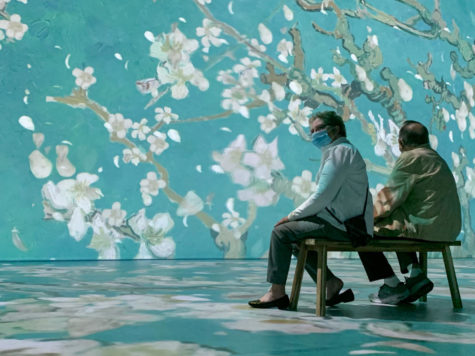
“From a visual aspect, I love the almond blossoms. There is just something about that scene that is just breathtaking and tranquil so if I am having a tough day in the office I go in there and kind of wait for that moment.” Silverstein said.
Silverstein goes on to speak on how this exhibit helps inspire children to go out and see more works of art due to their experience. The projections help fulfill one of their goals to expose children and get them pulled into the world of art.
“It gives kids especially a better understanding and a sense of excitement for art rather than just going into a museum and seeing it.” Silverstein said. “Our hope is kids come here and enjoy it so much that they go to the museum to see the four pieces of Van Gogh that are currently at the museum here in St. Louis. So hopefully it starts an appreciation of art at a deeper level for children than they normally would have.”
For those who plan on buying tickets, Silverstein stressed that masks are mandatory and necessary to keep the venue open.
“We must wear masks. It is the one actual problem we have enforcing because no one wants to wear their masks anymore. But it’s required and it’s a sign of the times,” Silverstein said.
Overall, the exhibit is open until Jan. 2 and Silverstein hopes that anyone who comes through the curtains leaves with something that is special and unique to the viewer.
“Ultimately, I want people to leave with a sense of joy that they were moved by what they saw, whether that’s just a ray of sunshine, whether it’s just a stir of emotions deep from within, or just having a great time hanging out with friends,” Silverstein said. “Art means something different to everybody and I just want everybody to experience what it is to them.”
Your donation will support the student journalists of Francis Howell Central High School. Your contribution will allow us to purchase equipment and cover our annual website hosting costs. FHCToday.com and our subsequent publications are dedicated to the students by the students. We hope you consider donating to allow us to continue our mission of a connected and well-informed student body.



